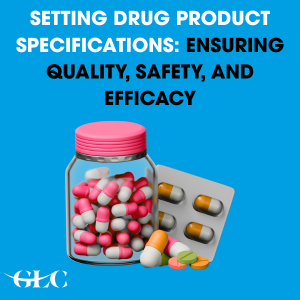Free knowledge to monitor the world of events. Have a look at our must read Blogs on Pharma, Finance, HR, Health and Cross Industry.
Setting Drug Product Specifications: Ensuring Quality, Safety, and Efficacy
2022-08-16
What determines the specifications in the first place? And how do companies get this balance right between regulatory demands, scientific understanding, and manufacturing realities?
In the pharmaceutical marketplace, defining drug product specifications is more than a regulatory requirementit's a guarantee of delivering patients safe, effective, and high-quality drugs. Specifications guide manufacturers to produce consistent products after consistent products, without variability, and ensure that patients receive the intended therapeutic effect.

But what determines these specifications in the first place? And how do companies get this balance right between regulatory demands, scientific understanding, and manufacturing realities?
What Are Drug Product Specifications?
Simply put, drug product specifications are a set of defined tests and acceptance criteria that a drug must meet to be considered safe and effective. These specifications typically cover aspects such as:
- Appearance (color, shape, clarity)
- Identity tests (confirming the correct active pharmaceutical ingredient)
- Assay (potency of the API)
- Impurity levels
- Dissolution or disintegration rates
- Microbial limits
- Stability over shelf life
These criteria are legally binding and must be justified by scientific data and risk assessments.
Why Are Specifications Important?
- Patient Safety and Drug Effectiveness: Specifications guarantee that the medicine performs its intended job without causing harm.
- Regulatory Compliance: Organizations like the FDA (USA), EMA (Europe), and MHRA (UK) require manufacturers to put in place and adhere to product specifications.
- Quality Control: Specifications are the foundation of the Quality Control (QC) testing plan to ensure consistently high-quality products.
- Manufacturing Variability Control: Placing constraints on impurities, strength, and other characteristics minimizes variability's impact on manufacturing.
Key Considerations in Setting Drug Product Specifications
1. Understanding of the Product and Its Intended Use
Specifications should provide for the drug's intended use, route of administration, patient population, and therapeutic range.
2. Risk Assessment
Quality attributes are analyzed for their relevance to safety and effectiveness. Critical Quality Attributes (CQAs) must be stringently controlled, while less significant ones can allow for broader ranges.
3. ICH Guidelines
Regulatory authorities use guidelines of the International Council for Harmonization (ICH), specifically:
- ICH Q6A: Specifications: Test Procedures and Acceptance Criteria for New Drug Substances and New Drug Products.
- ICH Q3A/B: Impurities in New Drug Substances/Products.
- ICH Q8-Q10: Pharmaceutical Development, Quality Risk Management, and Pharmaceutical Quality System.
4. Development Data and Manufacturing Experience
Preclinical, clinical, and manufacturing experience guide specifications:
- Batch analysis results
- Stability studies
- Process validation results
- Clinical trial data (to ensure batches used in trials meet proposed specifications)
5. Analytical Method Validation
Test procedures used for determining each attribute must be validated for accuracy, precision, sensitivity, and specificity according to ICH Q2 guidelines.
Specifications Evolve Over the Product Lifecycle
- Development Stage: Specifications may be more general to enable process variation.
- Commercial Production: As processes become stabilized and mature, specifications should tighten.
- Post-Approval: Continued monitoring (e.g., through stability studies and trend analysis) can lead to further specification tightening.
Key Challenges in Specification Setting
- Maintaining a balance between regulatory needs and reasonable production capabilities
- Coping with impurity profiles, especially for complex APIs and biologics
- Conforming to global regulatory demands
- Justifying specifications on scientific, not historical reasons
Evolving Trends
With the expansion of continuous manufacturing, biologics, and personalized medicine, the process for setting specifications is evolving. Post-approval change management processes and lifecycle management philosophies are more and more allowing manufacturers to rationalize specifications based on real-world data and enhanced process understanding.
Final Thoughts
Defining drug product specifications is a strategic activity where scientific know-how, regulatory instructions, and everyday manufacturing know-how are balanced. With a lifecycle approach and sound risk assessments, pharmaceutical companies can define specifications that are:
- Scientifically justified
- Reasonably implementable in practice
- Protective of patient health
- Globally regulatory compliant
A thoughtfully designed specification strategy not only ensures you're meeting today's quality standards but also prepares you for tomorrow's manufacturing landscape.
Do you want to understand more? Join our upcoming Setting Drug Product Specifications Masterclass.
By Shara Najimudeen, Digital Marketing Executive, GLC Europe, Colombo Office, Sri Lanka.
Get a feel for our events

Training Program for CMC Leaders - EU edition
27th October 2025 - 16th January 2026
Rich with practical insights and real-world applications
learn more >>
Training Program for CMC Leaders - US edition
27th October 2025 - 16th January 2026
Rich with practical insights and real-world applications
learn more >>
Mastering the Common Technical Document (CTD) for Biologics Masterclass - EU edition
12-16 January, 2026
From guidelines to submissions
learn more >>














